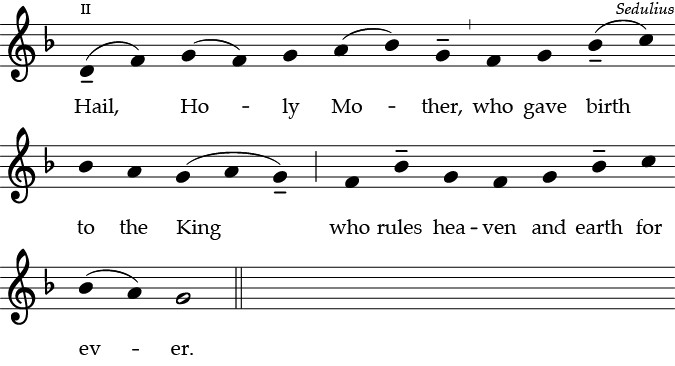Vernacular Plainsong for the Common of the Blessed Virgin Mary
-
I don't suppose to be original in adapting the Gregorian Melodies for vernacular plainsong. I would ask for some review/critique of these chants which I have composed and used a couple of times at masses of the Common of the Blessed Virgin Mary.
I'm thinking of using a different psalm tone termination for the Communion, and of course, there will be another version with Magnificat verses. I also need to review which translation of the psalter should be used, as I know that the approved translations vary around the world.
I was also going to work on a Gradual, but in light of common usage these days I think a plainsong responsorial psalm in similar style would be more useful.
So, please let me know what you think!
-
These are certainly nice to have on hand, though there are already versions available: I've been indexing parts of Burgess & Palmer that are missing from the American Gradual at CPDL.
I wonder which source did you follow for Salve sancta parens (the extra 't' must be a Cupertino effect)? The half notes on "King" let a lot of air out of the phrase if taken literally, though it makes more sense if interpreted as q q h with a horizontal episema.
Btw, first draft, I know, but "fa-vor-a-ble" is what we say around these parts of California. -
More like "auto-corrupt" strikes again!
-
The idea was that these would be something slightly more advanced than the SEP. Most of my vernacular plainsong adaptions are heavily based on Gregorian melodies. The idea being that the tune would be familiar enough so that you could read either the Latin or English versions and have the essence of the melodies align with each other.
-
"The idea being that the tune would be familiar enough so that you could read either the Latin or English versions and have the essence of the melodies align with each other"
I don't agree. Personally, I'm not a fan of putting a gregorian melody almost note for note above a vernacular text. Most of the time, the intimate relationship that existed between the Latin text and the music is lost that way. A vernacular text asks for a complete new composition, which may be inspired by the gregorian original of course, but it shouldn't be a near copy.
Two other points of critique:
- why didn't you use the translation from the Roman Missal (especially the introit)? Consistency in the use of liturgical texts is important when building a corpus of proper chants.
- I wouldn't give words like "and", "the" or "of" much attention by using a neume; for this kind of words a punctum should suffice.
For what it's worth, here's my (quick!) take on the introit Salve sancta Parens: Thanked by 1CHGiffen
Thanked by 1CHGiffen
Welcome to the MusicaSacra Forum!
To participate in the discussions on Catholic church music, sign in or register as a forum member, The forum is a project of the Church Music Association of America.
Categories
- All Discussions21,097
- General Music Discussion7,589
- Job Openings1,300
- Management of Music Programs833
- Choral Matters519
- Church Documents and Rubrics503
- CMAA Notes291
- Events651
- For Newcomers: Read First23
- Sacred Polyphony528
- Hymnody821
- Gregorian Chant: General2,582
- ↳ Graduale Romanum and Liber Usualis354
- ↳ Graduale Simplex55
- ↳ Semiology57
- Vernacular Plainsong671
- Anglican Use and Anglican Chant66
- Organ, Other Instruments and Repertoire414
- New Composition/Works in Progress1,208
- Recordings222
- Music for Hispanic Ministry151
- Music Education: Children205
- Music Education: General214
- News Items242
- Positions Wanted58
- General Discussion: Catholicism723
- Amusements170
- General Discussion1,000
- Opinions113



